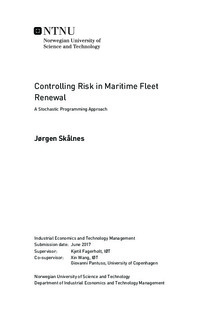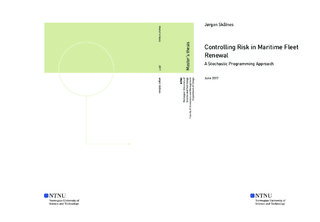| dc.description.abstract | This thesis considers the Maritime Fleet Renewal Problem (MFRP) including the risk of insolvency. The MFRP is a strategic problem with a planning horizon of several years. The literature review shows that relatively little research has been done for this problem, and that no one has treated risk explicitly.
Two stochastic models are developed to explicitly control the cash flow in order to reduce the risk of insolvency. One of the models, the cash flow control model, maximizes profit while limiting the worst case cash flow. The other model, the Conditonal Value-at-Risk (CVaR) model, uses CVaR as a risk measure. The CVaR model maximizes profit while limiting the expected minimum cash flow of the worst scenarios.
The computational study examines the effects of controlling the worst case cash flow for 12 distinct cases and demonstrates the impact on the expected profit. The CVaR model is solved for one of these cases, demonstrating how the decision maker can set a suitable risk level. The results from both models are based on a two-stage implementation, and a three-stage implementation is tested confirming that the two-stage simplification is reasonable.
The results from the computational study show that the strategies for improving the worst case cash flow are dependent on the situation. This demonstrates how complex the MFRP is, and how valuable such models can be to adapt the correct strategy for a given situation. In addition, this study shows that for increasing cash flow limits the expected loss in profit increases slowly at first, but then increasing almost exponentially. This is an important finding giving new insight for operations research considering strategic maritime problems. These results show that in many situations it is possible to reduce the risk of cash flow insolvency, with a limited loss in expected profit. Such models will hopefully help the decision makers determine a suitable trade-off between expected profit and risk. | |

